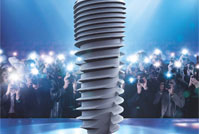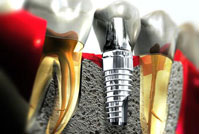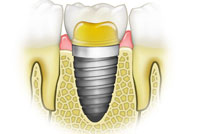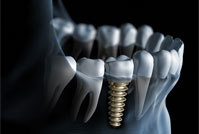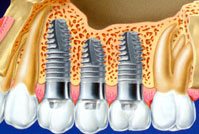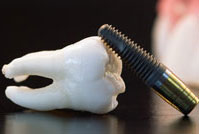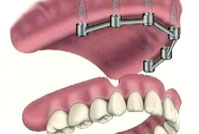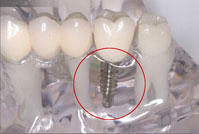Dental Implants In Ahmedabad
Dental implants provide a foundation for replacement teeth that look, feel, and function like natural teeth. Implants provide the patient with a natural appearance and facial contour that builds his/her confidence rendering better aesthetics, chewing efficiency and above all, a natural feeling. A healthy lifestyle starts with good oral health and we are committed to giving you a lifetime of beautiful, confident smiles.
What Are Dental Implants?
A dental implant is a metallic root of a tooth. It is placed in the bone of your jaw and allowed to heal in the bone for a period of time until the bone-implant union is strong enough to support a prosthetic tooth. The implant is made out of titanium, a metal that is very well tolerated by the human body Small posts that protrude through the gums are then attached to the implant. These posts provide stable anchors for artificial replacement teeth with preservence of facial structure and prevention of boneloss that occurs when teeth are missing.
The Surgical Procedure for Dental Implants
The most widely practiced method of placing dental implants is a "staged surgery" procedure. The first stage consists of surgically burying the implant (which replaces the tooth root) flush with the bone but underneath the gum. This protects the implant from force while it is healing. At the end of this healing period, the implant needs to be surgically exposed by removing some of the overlying gum.
After the implant has bonded to the jawbone, the second phase begins. We will uncover the implants and attach small posts that protrude through the gums and will act as anchors for the artificial teeth. When the artificial teeth are placed, these posts will not be seen. The entire procedure usually takes four to six months. Most patients experience minimal disruption in their daily life.
Immediate loading implants(tooth in an hour)
Using the most recent advances in dental implant technology, we are able to place single stage implants. These implants do not require a second procedure to uncover them, but do require a minimum of six to twelve weeks of healing time before artificial teeth are placed. There are even situations where the implants can be placed at the same time as a tooth extraction – further minimizing the number of surgical procedures. Advances in dental implant technology have made it possible, In selected cases at PARSHWA multispeciality dental clinic and Implant center,Ahmedabad,we can extract the teeth and give you new teeth in same visit. This procedure is called “immediate loading”.
Bone Grafting
Major & Minor Bone Grafting (Guided Bone Regeneration)
Over a period of time, the jawbone associated with missing teeth is reabsorbed. This often leaves a condition in which there is poor quality and quantity of bone not suitable for placement of dental implants. In these situations, most patients are not candidates for placement of dental implants.
But now your implantologist Dr Chirag shah is able to grow bone where needed. This not only gives us the opportunity to place implants of proper length and width, it also gives us a chance to restore functionality and aesthetic appearance.
Major Bone Grafting
Bone grafting can repair implant sites with inadequate bone structure due to previous extractions, gum disease or injuries. Sinus bone grafts are also performed to replace bone in the posterior upper jaw. In addition, special membranes may be utilized that dissolve under the gum and protect the bone graft and encourage bone regeneration. This is called guided bone regeneration or guided tissue regeneration.
Major bone grafts are typically performed to repair defects of the jaws. These defects may arise as a result of traumatic injuries, tumour surgery, or congenital defects. Large defects are repaired using the patient’s own bone. This bone is harvested from a number of different sites depending on the size of the defect. The skull (cranium), hip (iliac crest), and lateral knee (tibia), are common donor sites. These procedures are routinely performed in an operating room and require a hospital stay.
Sinus Lift Procedure (indirect and direct techniques)
The maxillary sinuses are behind your cheeks and on top of the upper teeth. Sinuses are like empty rooms that have nothing in them. Some of the roots of the natural upper teeth extend up into the maxillary sinuses. When these upper teeth are removed, there is often just a thin wall of bone separating the maxillary sinus and the mouth. Dental implants need bone to hold them in place. When the sinus wall is very thin, it is impossible to place dental implants in this bone.
There is a solution and it’s called a sinus graft or sinus lining graft. Your implantologist, Dr Chirag shah mds, enters the sinus from where the upper teeth used to be. The sinus membrane is then lifted upward and donor bone is inserted into the floor of the sinus. Keep in mind that the floor of the sinus is the roof of the upper jaw. In direct sinus lift technique, he enters from the sideways under the cheek, make a window and put the graft material inside sinus. After several months of healing, the bone becomes part of the patient’s jaw and dental implants can be inserted and stabilized in this new sinus bone.
The sinus graft makes it possible for many patients to have dental implants when years ago there was no other option other than wearing loose dentures.
If enough bone between the upper jaw ridge and the bottom of the sinus is available to stabilize the implant well, sinus augmentations and implant placement can sometimes be performed as a single procedure. If not enough bone is available, the sinus augmentation will have to be performed first, then the graft will have to mature for several months, depending upon the type of graft material used. Once the graft has matured, the implants can be placed.
Ridge Expansion
In severe cases, the ridge has been reabsorbed and a bone graft is placed to increase ridge height and/or width. This is a technique used to restore the lost bone dimension when the jaw ridge gets too thin to place conventional implants. In this procedure, the bony ridge of the jaw is literally expanded by mechanical means. Bone graft material can be placed and matured for a few months before placing the implant.
These procedures may be performed separately or together, depending upon the individual's condition. As stated earlier, there are several areas of the body that are suitable for attaining bone grafts. In the maxillofacial region, bone grafts can be taken from inside the mouth, in the area of the chin or third molar region, or in the upper jaw behind the last tooth. In more extensive situations, a greater quantity of bone can be attained from the hip or the outer aspect of the tibia at the knee. When we use the patient’s own bone for repairs, we generally get the best results.
In many cases, we can use allograft material to implement bone grafting for dental implants. This bone is prepared from cadavers and used to promote the patient’s own bone to grow into the repair site. It is quite effective and very safe. Synthetic materials can also be used to stimulate bone formation. We even use factors from your own blood to accelerate and promote bone formation in graft areas.
Nerve Repositioning
The inferior alveolar nerve, which gives feeling to the lower lip and chin, may need to be moved in order to make room for placement of dental implants in the lower jaw. This procedure is limited to the lower jaw and indicated when teeth are missing in the area of the two back molars and/or and second premolar, with the above-mentioned secondary condition. Since this procedure is considered a very aggressive approach (there is almost always some postoperative numbness of the lower lip and jaw area, which dissipates only very slowly, if ever), usually other, less aggressive options are considered first (placement of blade implants, etc.).
Typically, an outer section of the cheek side of the lower jawbone is removed in order to expose the nerve and vessel canal. Then we isolate the nerve and vessel bundle in that area and slightly pull it out to the side. At the same time, we will place the implants. Then the bundle is released and placed back over the implants. The surgical access is refilled with bone graft material of the surgeon’s choice and the area is closed.
What Types Of Prosthesis Are Available?
A single prosthesis (crown) is used to replace one missing tooth – each prosthetic tooth attaches to its own implant. A partial prosthesis (fixed bridge) can replace two or more teeth and may require only two or three implants. A complete dental prosthesis (fixed bridge) replaces all the teeth in your upper or lower jaw. The number of implants varies depending upon which type of complete prosthesis (removable or fixed) is recommended. A removable prosthesis (over denture) attaches to a bar or ball-in-socket attachments, whereas a fixed prosthesis is permanent and removable only by the dentist.
Why Dental Implants?
Once you learn about dental implants, you finally realize there is a way to improve your life. When you lose several teeth – whether it’s a new situation or something you have lived with for years – chances are you have never become fully accustomed to losing such a vital part of yourself.
Dental implants can be your doorway to renewed self-confidence and peace of mind.
Why Select Dental Implants Over More Traditional Types Of Restorations?
There are several reasons: Why sacrifice the structure of surrounding good teeth to bridge a space? In addition, removing a denture or a “partial” at night may be inconvenient, not to mention that dentures that slip can be uncomfortable and rather embarrassing. Implants preserve existing bone as well.
Are You A Candidate For Implants?
If you are considering implants, your mouth must be examined thoroughly and your medical and dental history reviewed. If your mouth is not ideal for implants, ways of improving outcome, such as bone grafting, may be recommended.
What Type Of Anaesthesia Is Used?
The majority of dental implants and bone grafts can be performed in PARSHWA multispeciality dental clinic and implant center under local anaesthesia, with sedation.
Do Implants Need Special Care?
Once the implants are in place, they will serve you well for many years if you take care of them and keep your mouth healthy. This means taking the time for good oral hygiene (brushing and flossing) and keeping regular appointments with Dr. Chirag Shah, your periodontist. Specific simple instructions are provided.
One Appointment
Computer-guided implant surgery is done in each and every patient of us. This benefits the patient in that there is less postoperative discomfort, less swelling and less bruising. Patients can often resume their normal activities the next day.
The process starts when a CAT scan is taken of the patient's jawbone. This CAT scan allows for the generation of a three-dimensional model of the jawbone. The results are more accurate implant placement, and less chair time for the patient at the surgery office.






